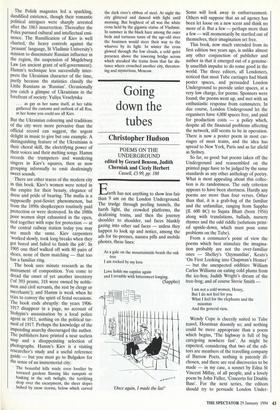A frontier settlement at heart
Raymond Asquith
KIEV: A PORTRAIT, 1800-1917 by Michael F. Hamm Princeton University Press, £21.95, pp. 304 Kiev has been to Russia as Jerusalem to the Crusaders, a source and goal of legitimacy, a city to be taken and relin- quished in ultimately equal measures of disappointment. Kiev in the 19th century was largely Russia's, and Michael Hamm has written an erudite book on the most energetic period so far in the city's modern history. Happily he barely touches on the frayed nerve of ancient Kiev's state legacy, but his review of the early history explains why for 600 years it so little resembled a city. In 1240 Kiev's oldest enemy, nomads, extinguished the glories of Yaroslav and Monomakh. The population, then the size of London a century later, recovered from Batu Khan's assault only after the Napoleonic wars. When Catherine passed through in 1787 she carped accurately about 'all the ruins of what they call Kiev'. One hundred and fifty years ago Khreshchatyk, now the central axis of the city, was a wooded ravine and swampy stream, ideal for snarers and distilling shacks.
By then Kiev had become a frontier settlement at heart, and beneath a Russi- fied veneer it began to prosper from its rich blend of peoples. Armenians, Greeks and Turks shared the river with the dominant Slavic traders, and the Tatars' camels were still arriving with Crimean wines and grapes in the summer months of the First War. The Jews leavened provincial life and contributed to the city's booming energy once Alexander II lifted Kiev's exclusion from the Pale of Settlement. Their suffer- ings in the 1881 and 1905 pogroms were severe, but Hamm shows that few ordinary Kievans took part. Most terrifying for the Jews must have been the connivance of the authorities with the mob — on the final day of the worst pogrom it numbered no more than 60 — in an effort to distract attention from Nicholas II's political con- cessions. The Poles, Russians and Ukraini- ans jostled for cultural and mercantile ascendancy under a more or less secure imperial regime, municipally incompetent, fitfully repressive and nervous, but usually oblivious of undercurrents and incurably relaxed — the hallmark of Kiev. The Polish magnates led .a sparkling, dandified existence, though their romantic political intrigues were sharply arrested after the 1863 insurrection. Thereafter the Poles pursued cultural and intellectual emi- nence. The Russification of Kiev is well charted,• the heavy controls against the `peasant' language, St Vladimir University's mission to disseminate Russian influence in the region, the suspension of Magdeburg Law (an ancient grant of self-government). Hamm's technique less successfully inter- prets the Ukrainian character of the time, partly because the statistics classify the Little Russians as 'Russian'. Occasionally you catch a glimpse of Ukrainians in the forefront of society: Yuliya Veselytska
. . . as gay as her name itself, at her table gathered the customs and outlook of all Rus, at her home you could see all Kiev.
But the Ukrainian colouring and traditions of the city were more pervasive than the official record can suggest, the urgent delight in music to give but one example. A distinguishing feature of the Ukrainians is their choral skill, the electrifying power of their voices and their melting songs. Hamm records the trumpeters and wandering singers in Kiev's squares, then as now grouping informally to emit deafeningly sweet sounds.
There are other traces of the modern city in this book. Kiev's women were noted in the empire for their beauty, elegance of dress and pride of bearing. The mafia is a supposedly post-Soviet phenomenon, but from the 1890s shopkeepers routinely paid protection or were destroyed. In the 1880s poor women slept exhausted in the open, tied together with rope for protection — at the central railway station today you may see much the same. Kiev carpenters `worked slowly, took long breaks when they got bored and failed to finish the job'. In 1905 one thief walked off with 80 pairs of shoes, none of them matching — that too has a familiar ring.
The book uses minute research as the instrument of composition. You come to dread the onset of yet another inventory ('of 393 prams, 318 were owned by noble- men and civil servants, the rest by clergy or merchants'); and Hamm is weak when he tries to convey the spirit of festal occasions. The book ends abruptly: the years 1906- 1917 disappear in a page, no account of Stolypin's assassination by a local police agent in 1911, nothing on the political tur- moil of 1917. Perhaps the knowledge of the Impending anarchy discouraged the author. The publishers have printed a near useless map and a disappointing selection of photographs. Hamm's Kiev is a visiting researcher's study and a useful reference guide — but you must go to Bulgakov for the sense of an immemorial city:
The beautiful hills made even lovelier by terraced gardens flaming like sunspots or basking in the soft twilight, the terrifying drop over the escarpment, the sheer slopes lashed by snow storms, below which curved the dark river's ribbon of steel. At night the city glittered and danced with light until morning. But brightest of all was the white cross held by the gigantic statue of Vladimir. In summer in the black haze among the osier beds and tortuous turns of the age-old river the boatmen would steer their way to the wharves by its light. In winter the cross glowed through the low clouds, a cold quiet presence above the towering bridge across which streaked the trains from that far dis- tance where crouched another city, threaten- ing and mysterious, Moscow.



































































 Previous page
Previous page